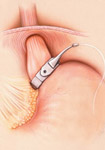Lap Band
LAP-BAND® System Overview
In this procedure, a hollow band made of special material is placed around the stomach near its upper end, creating a small pouch and a narrow passage into the larger remainder of the stomach. The band is then inflated with a salt solution. It can be tightened or loosened over time to change the size of the passage by increasing or decreasing the amount of salt solution. The entire procedure is done laparoscopically, where a laparoscope is inserted through the abdominal wall through small surgical incisions.
It induces weight loss by reducing the capacity of the stomach, which restricts the amount of food that can be consumed.
Minimally Invasive Approach
During the procedure, surgeons usually use laparoscopic techniques (using small incisions and long-shafted instruments), to implant an inflatable silicone band into the patient's abdomen. Like a wristwatch, the band is fastened around the upper stomach to create a new, tiny stomach pouch that limits and controls the amount of food you eat. It also creates a small outlet that slows the emptying process into the stomach and the intestines. As a result, patients experience an earlier sensation of fullness and are satisfied with smaller amounts of food. In turn, this results in weight loss.
Least Traumatic Procedure
Since there is no cutting, stapling or stomach re-routing involved in the LAP-BAND System procedure, it is considered the least traumatic of all weight loss surgeries. The laparoscopic approach to the surgery also offers the advantages of reduced post-operative pain, shortened hospital stay and quicker recovery.
Adjustable Treatment
The LAP-BAND System is an adjustable weight loss surgery. The diameter of the band is adjustable for a customized weight-loss rate. Your individual needs can change as you lose weight.
To modify the size of the band, its inner surface can be inflated or deflated with a saline solution. The band is connected by tubing to an access port, which is placed well below the skin during surgery. After the operation, the surgeon can control the amount of saline in the band by entering the port with a fine needle through the skin.
The LAP-BAND® System Advantage
Minimal Trauma
- Least invasive surgical option
- No intestinal re-routing
- No cutting or stapling of the stomach wall or bowel
- Reduced patient pain, hospital length-of-stay and recovery period
Fewer Risks and Side Effects
- Significantly lower mortality risk than other obesity surgery procedures
- Low risk of nutritional deficiencies associated with gastric bypass
- Reduced risk of hair loss
- No “dumping syndrome” related to dietary intake restrictions
Adjustable
- Allows individualized degree of restriction for ideal, long-term weight loss Adjustments performed without additional surgery
- Supports pregnancy by allowing stomach outlet size to be opened for increased
nutritional needs
Reversible
- Removable at any time
- After removing the gastric band, some of the scar tissues around the stomach will remain and might increase risks of any subsequent revision surgeries
-
Sleeve Gastrectomy
Sleeve gastrectomy also referred to as vertical sleeve, gastric sleeve or tube gastrectomy is a surgical procedure performed for the treatment of obesity.
-
Gastric Bypass
Roux-en-Y gastric bypass (RYGB), commonly called simply "gastric bypass", is one of the most popularly performed bariatric procedures worldwide and has long been considered the "gold standard" of bariatric surgery.
-
Mini Gastric Bypass
The One Anastomosis Gastric Bypass (OAGB), also known as "mini-gastric bypass" was first reported in 2001. The OAGB is a minimally invasive procedure performed with laparoscopic technique.
-
Lap Band
In this procedure, a hollow band made of special material is placed around the stomach near its upper end, creating a small pouch and a narrow passage into the larger remainder of the stomach.
-
Intragastric Balloon (Orbera)
Gastric balloon, also called endoscopic intragastric balloon, is a non-surgical weight-loss procedure which involves the insertion of a specialized balloon inside the stomach to occupy space and limit the food carrying capacity of the stomach.





